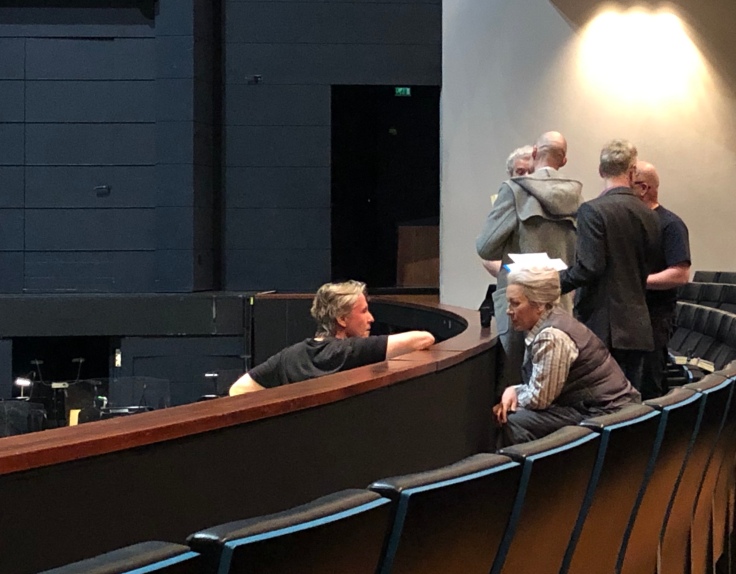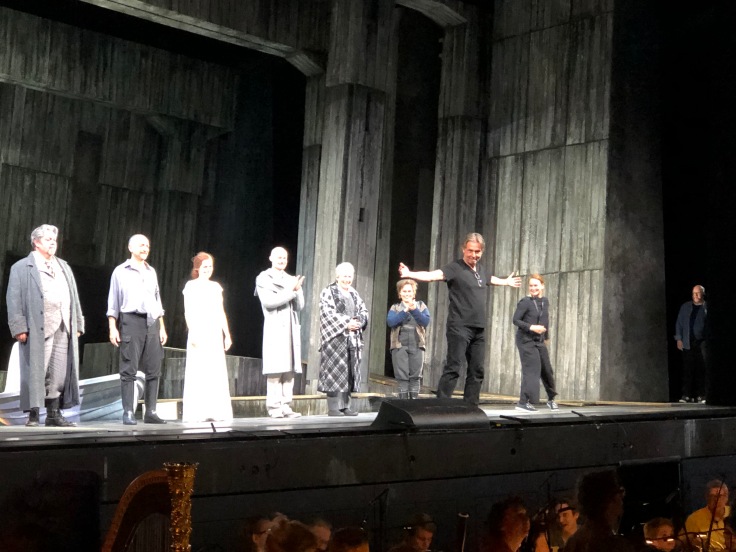
On a Monday evening in mid-May, the orchestra of the Finnish National Opera and their Artistic Partner, conductor Esa-Pekka Salonen are gathered in the rehearsal hall at the basement of the opera house, to start their work with Claude Debussy’s opera Pelléas et Mélisande (1893-1902), based on Maurice Maeterlinck’s 1892 symbolist play.
Debussy’s original intention was to set Maeterlinck’s text to music in its entirety, though it soon became evident that some cuts were necessary in order to keep the pacing and duration of the opera practicable. Despite this condensation, the libretto remains closely tied to the original text of the play.
Musically, Pelléas et Mélisande is a fascinating mix of dream-like orchestral hue (derived from the symbolism of the play itself) and speech-like, quasi-realistic vocal lines. There are no melismas nor repetitions found in Debussy’s vocal writing. Often set in monotones or sublime melodies devoid of dramatic leaps, there is unique enchantment embedded in the vocal lines.
Save from brief moments in the fourth act, the vocal lines do not overlap each other. Instead they follow the manner of a conversation, resulting in a lyric drama, as indicated by the piece’s subtitle.
In the orchestral writing, there is more Wagner than meets the eye. These Wagnerian traits are probably most obvious in the fourth act, the first one to be set to music by Debussy. Yet, throughout the score, Debussy’s orchestral writing echoes the Bayreuth master with its recurring motives and advanced harmonies. Still, the music is always unmistakably Debussyan, yielding to truly one-of-a-kind operatic endeavour.
Despite many attempts before and after, Pelléas et Mélisande was to be the only finished opera by Debussy. In its uniqueness, it is also one of the most perfect pieces of music theatre ever deviced. For Salonen, it is a very special score, the one that would accompany him on a desert island.
Over the past thirty or so years, Salonen has conducted the opera on many occasions, his previous engagement with it being at the Festival d’Aix-en-Provence in July 2016, a production staged by Katie Mitchell.
Salonen’s love for Pelléas at Mélisande was kindled in his teens, with the recording conducted by Pierre Boulez. At the beginning of the first orchestra rehearsal, Salonen recalled how he used to take the recording with him to parties, and made everybody listen lengthy excerpts of the opera. A tactics he now deems socially somewhat unsuccessful.
Unlike most symphony orchestras, with their subscription series featuring different programme each week, usually performed only once or twice, opera orchestras get to spend much longer times with each piece. As such, the production keeps evolving and maturing as it runs, with added depth.
Being a part of the key repertoire, opera orchestras are rather familiar with Pelléas et Mélisande. Therefore relatively little rehearsal time is needed to put a performance together. At the Finnish National Opera, the rehearsal period consisted of three orchestral rehearsals, a sitzprobe and two stage rehearsals, alongside piano rehearsals with singers.
The stage production by Marco Arturo Marelli was premiered at the Finnish National Opera in 2012 and first revived in 2014. It’s speciality is water, which floods the center of the stage, as a key visual element of the drama.
With each revival, a production is renewed, with each cast and conductor adding their musical input providing new perspectives. Salonen’s cast included some of his long-time collaborators, such as soprano Camilla Tilling (Mélisande) and baritone Laurent Naouri (Golaud), who also sang the role with Salonen at Aix-en-Provence. Baritone Ville Rusanen (Pelléas) sang the role in the 2014 revival. In addition, the production featured the Artistic Director of the FNO, mezzo-soprano Lilli Paasikivi as Génevieve, bass Jyrki Korhonen as Arkel and soprano Mia Heikkinen as Yniold.

Debussy wrote Pelléas et Mélisande in short score in 1893-95, with notable revisions carried out during the following years, for example the revision of the fourth act in 1900. Neither full score nor vocal score existed until Debussy had finally secured the 1902 Paris premiere with Opéra Comique in May 1901.
With the premiere performances now ahead, Debussy reworked the fourth act yet again, and started work on the vocal score, which was eventually completed in September 1901. With the vocal score finished, Debussy then moved on to produce the full orchestral score.
With limited time at his disposal, Debussy concentrated on the instrumental parts, leaving the vocal lines mostly for his copyist to enter into the full score. As a result, there are some discrepancies between the vocal score and the full score, leading to some contradictory details between the materials. In addition, there were further revisions by Debussy following the Opéra Comique production, which have made it to published editions with varying success.
Thus, one key element of rehearsals is aligning the score and parts together by correcting mistakes and misprints, as well as solving contradictions. Despite several previous productions, there were still some misprints left in the orchestral parts of the FNO orchestra, now corrected in rehearsals with Salonen.
Given the genesis of Debussy’s autograph score and its numerous retouches, it is hardly surprising that some mistakes and misprints endure from one printed edition to the next. In addition, Debussy’s notation is extremely detailed, filled with slurs and dots, carefully marked dynamics, meticulously articulated rhythms and a myriad of tempo indications.
During rehearsals, Salonen mused over Debussy’s obsession for detail, and the story of the composer visiting his publisher, Durand, on the very last day of his life, still adding some details for the revised edition of the score of La Mer, ahead of its publication.
Within the three three-hour orchestral rehearsals, Salonen and the FNO orchestra work their way through the opera in a straightforward manner. Salonen starts by stating briefly some general ideas about phrasing, rhythm and the overall character of the music. Soon the hall is resounding with the shadowy opening bars of the score.
Salonen has a clear vision of the opera he knows intimately and which has conducted many times before. Much is communicated while playing, through gesture, eye-contact and brief but apt verbal instructions. He only stops the music when it is absolutely necessary to clarify something in a more detailed manner.
Based on his craft and experience, Salonen knows where the challenges lie. With an orchestra quick to respond, the rehearsals proceed swiftly and smoothly. Contrary to the maestro myth of a, luckily, bygone age, rehearsals are not one-way street, but essentially dialogue between the musicians and the conductor, with each influencing the other. At times Salonen, picks up a phrase from the orchestra, and though the orchestral playing differs from his initial idea, he chooses to go with the orchestra.
There are 110 musicians in the FNO orchestra. Since the score of Pelléas et Mélisande calls for c. 75 players, the line-up in the pit varies from performance to performance somewhat, as the players work in shifts. The same goes with the rehearsals. As always, all the key information is marked in the parts, where it stays for each player to pick it up. The parts carry traces from past performances as well, thus leading to more lasting tradition.
The singers and the orchestra are first joined together in sitzprobe, where the vocal and instrumental layers of the music are integrated, in terms of balance and pacing. With a standard repertoire piece, sitzprobe is usually quite straightforward affair, a detailed run-through of the score, with some adjustments here and there.
Following the sitzprobe, two days of stage rehearsals ensue, each with a complete sequence of all five acts with one intermission. Musically, by this point, it is mostly about fine-tuning the dynamics for optimal balance between the singers and the orchestra. This includes some adjustments for the timing of crescendos and diminuendos.
In Pelléas et Mélisande, the choir makes only one brief offstage appearance in the closing scene of the first act, portraying a crew of a ship sailing away. In the manner of the opening scene of Wagner’s Der fliegende Holländer, the choral part consists of brief navigating calls, heard in the distance.
At the FNO, the choir sings from behind the orchestra pit. With some work on the balance, the desired outcome is achieved, with nice lontano touch.
At the dress rehearsal, all pieces are in their right place. At the start of the day, Salonen takes a moment with the orchestra to give the final touches on balance here and there. Soon, everything is ready. The lights are dimmed, and we are on our way to the exquisite realm of Allemonde.

© Jari Kallio